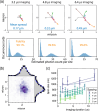Fast single atom imaging for optical lattice arrays
- PMID: 39863596
- PMCID: PMC11762994
- DOI: 10.1038/s41467-025-56305-y
Fast single atom imaging for optical lattice arrays
Abstract
High-resolution fluorescence imaging of ultracold atoms and molecules is paramount to performing quantum simulation and computation in optical lattices and tweezers. Imaging durations in these experiments typically range from a millisecond to a second, significantly limiting the cycle time. In this work, we present fast, 2.4 μs single-atom imaging in lattices, with 99.4% fidelity - pushing the readout duration of neutral atom quantum platforms to be close to that of superconducting qubit platforms. Additionally, we thoroughly study the performance of accordion lattices. We also demonstrate number-resolved imaging without parity projection, which will facilitate experiments such as the exploration of high-filling phases in the extended Bose-Hubbard models, multi-band or SU(N) Fermi-Hubbard models, and quantum link models.
© 2025. The Author(s).
Conflict of interest statement
Competing interests: M.G. is a cofounder and shareholder of QuEra Computing. All other authors declare no competing interests.
Figures





References
-
- Jaksch, D., Bruder, C., Cirac, J. I., Gardiner, C. W. & Zoller, P. Cold bosonic atoms in optical lattices. Phys. Rev. Lett.81, 3108 (1998).
-
- Greiner, M., Mandel, O., Esslinger, T., Hänsch, T. W. & Bloch, I. Quantum phase transition from a superfluid to a Mott insulator in a gas of ultracold atoms. Nature415, 39 (2002). - PubMed
-
- Gross, C. & Bakr, W. S. Quantum gas microscopy for single atom and spin detection. Nat. Phys.17, 1316 (2021).
-
- Altman, E. et al. Quantum simulators: architectures and opportunities. PRX Quantum2, 017003 (2021).
-
- Daley, A. J. et al. Practical quantum advantage in quantum simulation. Nature607, 667 (2022). - PubMed
Grants and funding
- DE-AC02-05CH11231/U.S. Department of Energy (DOE)
- PHY-1734011/National Science Foundation (NSF)
- W911NF2010104/United States Department of Defense | United States Army | U.S. Army Research, Development and Engineering Command | Army Research Office (ARO)
- N00014-18-1-2863/United States Department of Defense | United States Navy | Office of Naval Research (ONR)
- GBMF11521/Gordon and Betty Moore Foundation (Gordon E. and Betty I. Moore Foundation)
LinkOut - more resources
Full Text Sources

